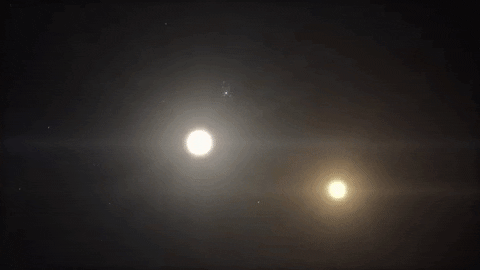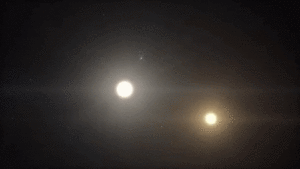For a long time, this was a purely theoretical question. Over the past decade or so, however, astronomers have found more than a dozen confirmed instances of “circumbinary planets”—that is, planets that orbit around a close double star.
A particularly interesting case is the planet Kepler-1647b, which circles two roughly sunlike stars. This planet also resides in the “habitable zone,” the region around the two stars where the planet could have the right temperature for liquid water.
What if Earth had two suns instead of one? Let’s consider a simple scenario. Suppose we replaced the sun with two closely matched stars, each half as bright as the Sun. In that case, the amount of energy reaching the Earth would still be the same, and life would still be possible here. Such equal-mass binaries are not uncommon, so this scenario seems perfectly plausible.
The mass of each of our new suns would be about 85% of the mass of our current sun. That may seem surprising, but the luminosity of a star is extremely sensitive to mass. Roughly speaking, luminosity goes as the 4th power of mass, so doubling the mass of a star increases its brightness by a factor of 16. A 15% mass reduction is enough to cut a star’s brightness in half.
The combined mass of Sun 1 and Sun 2 would be 1.7 times the mass of our current sun. Since their total gravity would be stronger, the length of a year would be a bit less: about 280 days instead of 365 days. Not that radical of a change, really.
So far so good. But would the Earth be stable in its new configuration, orbiting around two stars instead of one? The case of Kepler-1647b and other circumbinary stars gives a strong YES answer here. As long as the distance to the planet is at least about 4 times as great as the separation between the two stars, the planet just happily orbits around the stars’ centre of mass. If Sun 1 and Sun 2 are less than 15 million kilometres apart, then all of the planets in the solar system (even Mercury) could potentially be stable.
Just to be safe, let’s put the stars closer together, about 5 million kilometres apart. That’s not so different than the two stars of Kepler-1647, which are about 7 million miles apart. Our Sun 1 and Sun 2 would orbit each other once every 10 days or so. They would also each rotate with a 10-day period, which would make them a little more active than our current sun, but not outrageously so. The Kepler-1647 stars are reasonably peaceful.
The two suns would probably appear to orbit each other roughly edge-on as seen from Earth, which would lead to a strange new phenomenon: an eclipse of the sun by another sun! Because of the 10-day orbit, Sun 1 and Sun 2 would pass in front of each other every 5 days. The eclipses would last about 6 hours, and at peak would reduce the amount of energy reaching the Earth by about 30%–40%, depending on the exact geometry.
Eclipse days would be chilly, but the periods of reduced sunshine would be brief enough to average out smoothly into Earth’s overall climate. The double suns wouldn’t even look all that strange in the sky. At maximum separation, Sun 1 and Sun 2 would be only 2 degrees apart in the sky, just enough to give shadows a double edge. For about a half-day on either side of an eclipse, they’d seem to merge, though if they slipped behind a cloud you’d see an odd, oval shape from the overlapping disks. Sunsets would be pretty, a little different each night.
All the evidence so far, then, is that a planet like Tatooine in Star Wars really could exist, and Earth would do just fine if it were orbiting a double star instead of our one lonely sun. There’s really just one huge unsettled question: Could such a planet form in the first place?
Kepler-1647b is a giant gas planet, nearly twice the mass of Jupiter. Even the smallest known circumbinary planet, called Kepler-453b, is a heavyweight, bigger than Neptune.
It may be that the environment around a double star is too chaotic to create small, rocky planets like Earth. Then again, it’s also possible that other Earths with two suns are common, and our telescopes simply are not sensitive enough to find them. At least, not yet.
Fortunately, better instruments are coming soon. In the coming decade, the PLATO space telescope and huge new ground-based observatories like the Giant Magellan Telescope and the Extremely Large Telescope will tell us a lot more about all kinds of planets around other stars—including possible Earthlike planets with double suns lighting up their skies.

